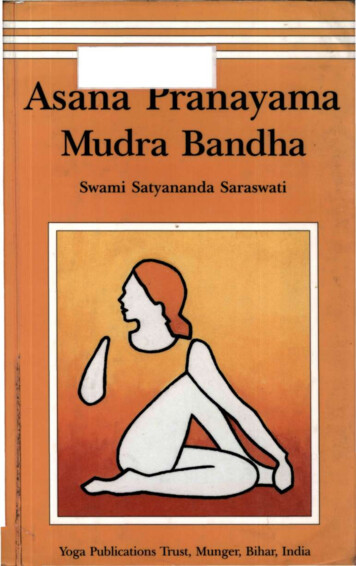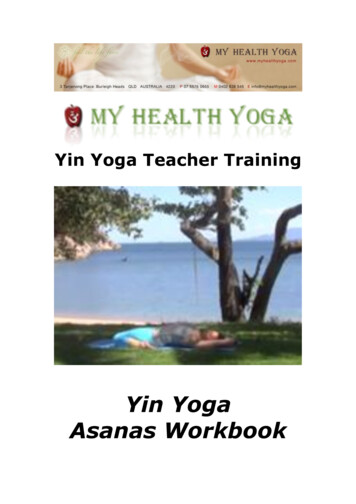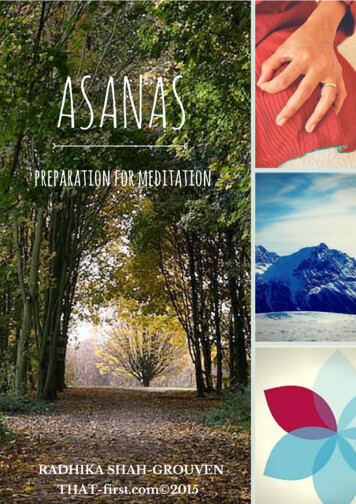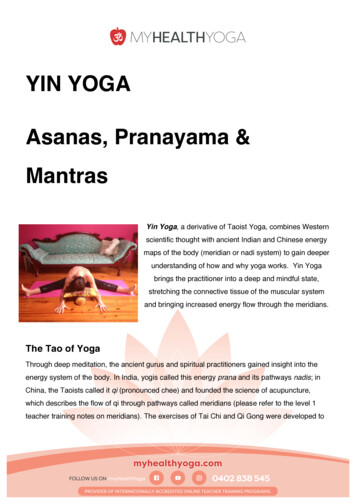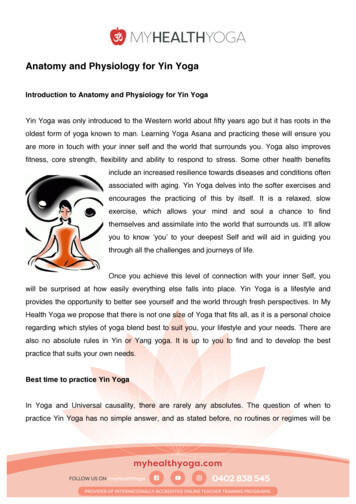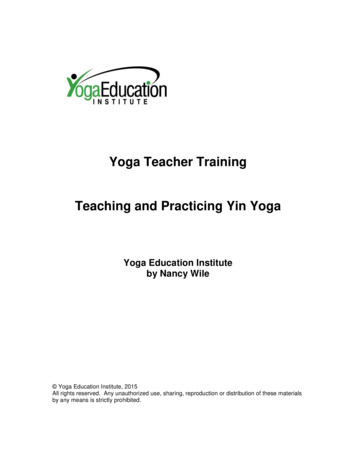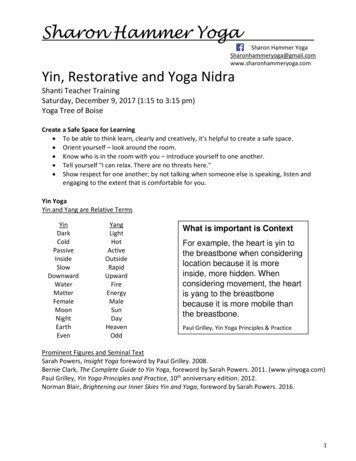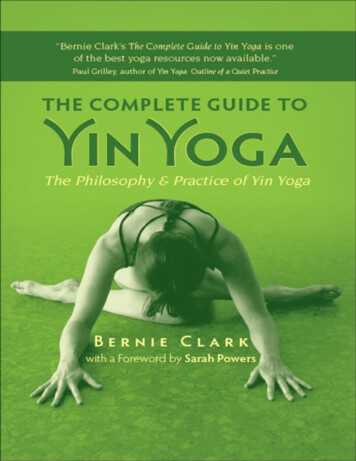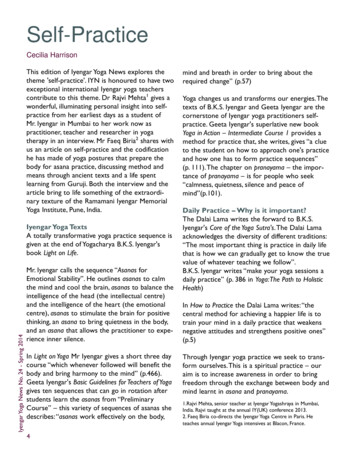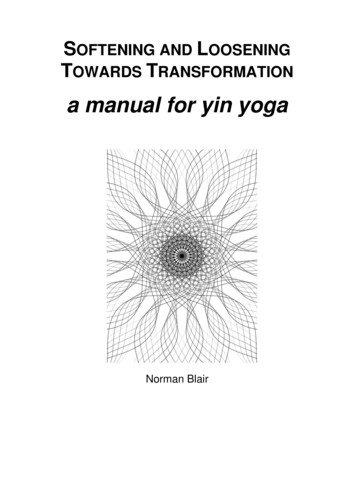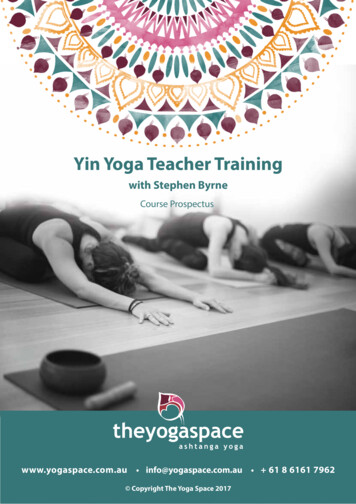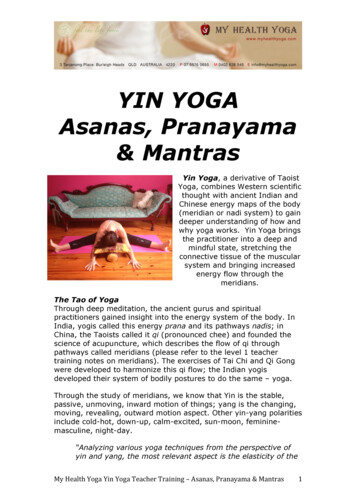
Transcription
YIN YOGAAsanas, Pranayama& MantrasYin Yoga, a derivative of TaoistYoga, combines Western scientificthought with ancient Indian andChinese energy maps of the body(meridian or nadi system) to gaindeeper understanding of how andwhy yoga works. Yin Yoga bringsthe practitioner into a deep andmindful state, stretching theconnective tissue of the muscularsystem and bringing increasedenergy flow through themeridians.The Tao of YogaThrough deep meditation, the ancient gurus and spiritualpractitioners gained insight into the energy system of the body. InIndia, yogis called this energy prana and its pathways nadis; inChina, the Taoists called it qi (pronounced chee) and founded thescience of acupuncture, which describes the flow of qi throughpathways called meridians (please refer to the level 1 teachertraining notes on meridians). The exercises of Tai Chi and Qi Gongwere developed to harmonize this qi flow; the Indian yogisdeveloped their system of bodily postures to do the same – yoga.Through the study of meridians, we know that Yin is the stable,passive, unmoving, inward motion of things; yang is the changing,moving, revealing, outward motion aspect. Other yin-yang polaritiesinclude cold-hot, down-up, calm-excited, sun-moon, femininemasculine, night-day.“Analyzing various yoga techniques from the perspective ofyin and yang, the most relevant aspect is the elasticity of nayama&Mantras1
tissues involved. Yang tissues like muscles are more fluidfilled, soft, and elastic; yin tissues like connective tissue(ligaments, tendons, and fascia) and bones are dryer, harder,and stiffer. By extension, exercise that focuses on muscletissue is yang; exercise that focuses on connective tissue isyin.” (Paul Grilley)There is a movement in Western forms of yoga towards a more‘yang’ practice such a Vinyasa, Power, and Ashtanga yoga. Thesestyles of yoga infuse the muscles with blood, as do standing poses,Sun Salutations, or inversions. Once the muscles fill with blood,they become much easier to stretch. Yang-style yoga is wonderfulfor detoxing the body and emotions, conditioning the cardiovascularsystem and strengthening the muscles and mind. It could bedebated that deep flexibility and stillness of mind, however, isgenerally not achieved through yang-style asanas to the degree towhich yin yoga practice can. Yin-style yoga of holding poses for atleast 3-5 minutes, brings greater flexibility to the body through therelease of the connective tissue. Yin poses also develop the abilityto meditate within the asana, giving rise to a greater ability to sitfor longer periods of time in seated meditation (one of the ultimategoals of asana practice).The Joint Stretch“Why would Yin Yoga advocate stretching connective tissue?We must remember that connective tissue is different frommuscle and needs to be exercised differently. Instead of therhythmic contraction and release that best stretches muscle,connective tissue responds best to a slow, steady load. If yougently stretch connective tissue by holding a yin pose for along time, the body will respond by making them a littlelonger and stronger—which is exactly what you want. “ (PaulGrilley)Yin tissues that we are targeting are the denser, deeper, less elastictissues, such as the ligaments, joint capsules, cartilage, bones, andfascial networks of the body. Whilst connective tissue is found inevery bone, muscle, and organ, for Yin yoga we are most concernedmore with the connective tissue in the joints. If you don't use yourfull range of joint flexibility, the connective tissue will slowly shortento the minimum length needed for your everyday activities.Prolonged shortening of connective tissue will bring rigidity andinflexibility into the joints, minimizing physical activity, and makingthe body more susceptible to injury. We must remember anayama&Mantras2
practicing yin yoga that we need to completely relax our muscles toallow the prana to fully penetrate the connective tissue. This maybe counter-intuitive for some people who associate yoga with a‘workout’ and feel there has to be some kind of strain felt within themuslces. Yin Yoga reminds us to soften not just the muscularsystem of the body, but also our attitude so we may learn that ‘lessis more’.The Yin Yoga AsanasWe can assign any creative name to our Yin yoga asanas. There’sno right or wrong and like any standard yoga pose, there arevariations of the pose names from school to school. The idea is totake traditional Hatha yoga seated postures (no standing poses inyin yoga as it is not comfortable to hold for long periods of time)and adapt them. Each student will look different within the posebased on their intuitive and healing needs. Props are oftenessential to bring deep comfortability, yet are not mandatory. YinYoga is a cooling practice and as such, only a light warm-up of afew sun salutes is needed. Be sure to have blankets on hand forstudents as the body cools within the asana. Cooling is a naturalresponse when a person experiences a healing release. Shivering isactually encouraged as it creates a release of tension – this is thenervous system’s primary reflex to unlock subconscious blocks inthe body/mind. The prana literally shakes through the blocks,releasing what no longer serves our higher good. This phenomenonalso happens within yang style yoga practice and an unawareteacher or practitioner may seek to control these involuntarymovements, incorrectly believing they are fatigued. The shaking orpulsing must be encouraged for deep cellular healing. It is notuncommon for an orgasmic feeling to be experienced if the shakingis allowed to continue as all nadis (meridians) and chakras willultimately explode with light and prana (specifically Shakti energy –the feminine principle).It is important in Yin yoga stretches to be very physicallycomfortable. Observe your facial expressions – the face needs tobe relaxed – any tightening of the face is a sign to ease off.Proceed cautiously, gradually extending the depth of poses and thelength of time you spend in them (very gentle poses can be held upto 20 minutes, however, we may term this ‘Restorative as,Pranayama&Mantras3
The Three Tattvas of Yin Yoga PracticeA tattva is the reality of a thing, or its category or principal nature.Sarah Powers offers us three very simple and very effectiveprinciples for the yin practice.1. Come into the pose to an appropriate depth ;2. Resolve to remain still ;3. Hold the pose for time.To give a deeper understanding of the Three Tattvas on Yin YogaPractice, we can expand on each point:1. Bring your student into the pose to their full extension initiallyso they are aware of where the point of resistance is withinthe pose. If we were to hold the asana at full extension forfive minutes, we would injure ourselves – therefore, ask yourstudent to ease back from the full extension to a place wherethey are simultaneously comfortable but still feeling energy(prana) in their meridians (ie. still feeling a gentle release).Yin Yoga encourages the practitioner to find their own natural,organic shape within the pose. If your intuition wants you toturn your head to the side; bend your knee/elbow; round yourspine etc, you must do so. The body has it’s own divineintelligence and will move to a place within the pose that willconduct the best throughput of energy, providing the highestform of healing. Each body is different and if there has beenrepetitive movement and injury within the body, it may beappropriate to find a shape within the body that best‘unravels’ the blockage. This can be counter-intuitive to thestrict alignment techniques within other styles of yoga andcan challenge many experienced ‘yang’ style yogapractitioners. Be prepared to break all the rules and listen tothe inner guidance!2. If you cannot remain still within the pose, you need to keepmodifying the asana until you can. Meditation is the goalhere. Small movement is allowed to deepen into a pose asthe mind/body relaxes. Exploring deeper states ofconsciousness within, facilitated by this powerful internalpractice, can mean the body will suddenly ‘unlock’ long-heldblockages. As such, the practitioner is allowed to move todeepen the pose as feels appropriate. Fidgeting, scratching,looking around etc is distracting and not encouraged. Nodarting gaze is allowed either and it is recommended anayama&Mantras4
there is no dristhi; rather, the eyes are closed.3. 5 minutes is recommended in a Yin yoga pose due to the factthat it takes 2.5minutes to activate the connective tissue;hence the remaining 2.5minutes is where the release andhealing occurs. If you the Yin pose is fairly dynamic, a 3 or 4minute hold is suitable. Ensure that if the pose requires leftand right sides of the body, the time is held equally on bothsides of the body.The Flow of Qi“Even if you only spend a few minutes a couple times a weekpracticing several of these poses, you'll be pleasantlysurprised at how different you feel when you sit to meditate.But that improved ease may not be the only or even the mostimportant benefit of Yin Yoga. If Hiroshi Motoyama and otherresearchers are right—if the network of connective tissue doescorrespond with the meridians of acupuncture and the nadisof yoga—strengthening and stretching connective tissue maybe critical for your long-term health.Chinese medical practitioners and yogis have insisted thatblocks to the flow of vital energy throughout our bodyeventually manifest in physical problems that would seem, onthe surface, to have nothing to do with weak knees or a stiffback. Much research is still needed to explore the possibilitythat science can confirm the insights of yoga and TraditionalChinese Medicine. But if yoga postures really do help us reachdown into the body and gently stimulate the flow of qi andprana through the connective tissue, Yin Yoga serves as aunique tool for helping you get the greatest possible benefitfrom yoga practice.” (Paul Grilley)PranayamaMaharaja Pranayama is the most appropriate breathwork techniqueto use in a yin yoga pose. Also known as the ‘royal breath’,Maharaja Pranayama involves 3 part nostril breathing on theinhalation and 3 part breathing on the exhalation. Whilst there isno pause between the 3 parts, or chambers, of the torso, there is adefininite order to fill the lower belly, then ribcage, then chest onthe inhalation and a reversal of the 3 chambers on the exhalation.There is also a strong focus on creating an evenness of breath, ayama&Mantras5
that the rhythm of the in-breath is even to the rhythm of the outbreath. For beginners, it may be useful to count on the inhalationand match the exhalation with the same count – eg. Inhale, 1, 2, 3,4, 5; Exhale 1, 2, 3, 4, 5 (or whatever count matches the length ofbreath).3 Part BreathingYogis use 3 part breathing (known as Maharaja Pranayama) inevery yoga practice with the intention to use 3 part breathing inevery moment of life. There is a traditional belief that we are onlyassigned a certain number of breaths per lifetime and we will havelongevity if we learn to slow down our breathing. People who runaround busy all the time will weaken their energy and their heartand are likely to either have illness or shorten their life expectancy.The nature of our breath tells many stories. If our inhale is longerthan our exhale, we beome over-excited and jittery as we increaseadrenaline production. Many people believe this sounds appealing,yet, we cannot sustain this space and ultimately it will lead toanxiety and panic attacks as well as adrenal fatigue. If our exhale islonger than our inhale we become depressed and feel the world is adark place. Be mindful of people when you say 'how are you?' andthey sigh first before answering: "(long sigh).I'm ok". You knowthey're not ok. Long, slow, deep, EVEN breaths are the key tomental and emotional stability, giving rise to Higher Connection,creativity, health, wellbeing and joyous contentment. It's a place offeeling comfort in both the fullness of the in-breath and theemptiness of the out-breath. The pause and interchange betweeneach breath, when observed acutely can lead to ecstasy. YourUniversal Self exists in this space - a place without the usualunbalanced controlling, “if only ”, “what if ” mind chatter. Enterinto heightened awareness of that delicious throbbing pulsation thatis your Pure Divinity.How to do 3 part breathing:Sit up straight or lay on your back. When doing a healing session,talk your client through these steps and repeat until you can seethe rise and fall of the breath from lower belly to collarbones andback down again.InhalingAir is inhaled through the nose – the lower bellyblossoms open, drawing the breath into the ribs. Theribs expand upwards and sideways, drawing the breathto the chest. The chest fills to the collarbones. It ayama&Mantras6
said we have three chambers in the torso to fill as weinhale.ExhalingAir is exhaled through the nose – decreasing the volumeof the chest – the lungs contract, squeezing out stale airand physical/emotional toxins, the rib cage inwards anddown and the lower belly naturally empties (the navelautomatically draws towards the spine without effort).Remember to empty all three chambers on theexhalation.To get the most out of the breathing exercises, good respirationbegins with a slow, long exhalation and the lungs should notcompletely empty during exhalation, nor do they fill completelyduring inhalation. About 10% of stale air stays in to keep the lungsinflated. It is important to practice natural breathing every day untileffective breathing has become natural.Testing your BreathingYou can either sit in a chair or lay down on the floor. Lie on your back and place each hand lightly on the lower belly,parallel with the bottom ribs, fingertips touching. Becomemindful of your body.Breathe in slowly, deeply and silently. Feel the lower belly moveoutward and notice your hands also moving outward, fingertipsmoving apart, as the belly expands.Breathe out slowly, smoothly, and silently. Concentrate on thefeeling in the lower belly. Notice the lower belly contracting andfingertips touching again.Move one of your hands to rest lightly on your chest, breathe.Concentrate on detecting any differences in the movements ofyour chest.Repeat steps 1-3, squeezing the lower belly on out-breaths andreleasing on in-breaths, for up to five minutes. Relax for a fewminutes before getting up.Slow breathingA truly wonderful phenomenon occurs when we hold our Yin posesfor 3-5 minutes. We surrender to a deeper internal state, reachingan alpha and ultimately a theta brainwave. We generally functionin beta brainwave in our normal everyday reality – planning,problem-solving, analysing, making ‘to-do’ lists, regretting the anayama&Mantras7
and creating anxiety for the future. With yoga breathwork, we canimmediately enter a reduction of the mental oscillations, reachingalpha brainwave. This creates a feeling of internal space, as weliterally slow down the number of thoughts we have. Our organscan repair more easily in this state. When we become masters ofslowing our breathing even further, we can enter theta brainwave,also known as God or Universal Consciousness. In this space allthings become known and possible. In this space, miraculoushealing can occur. We can also manifest easily through prayer pluswe receive divine inspiration through revelation (opposite toanalysis where revelation is a spontaneous knowing rather than alogical deduction). In this space, we can talk to spirit guides,angels, loved ones who have crossed over, pets who have crossedover and ascended masters. Messages come through hearing,internal seeing, knowing and feeling – all aspects of intuition.Yin Yoga is a perfect opportunity to enter alpha and thetabrainwaves and creates inspired motivation to practice regularly.When you have the experience of ‘being breathed’, you haveentered theta brainwave. Often when this first occurs, weimmediately start thinking again, in an attempt to label this deeppeaceful bliss we are experiencing. Of course, this rapidly takes usout of the theta brainwave. When we practice regularly, webecome comfortable in a state of non-thinking or non-mind and canrejuvenate deeply in these long held meditative states.KriyasYin Yoga is exceptional to bring stored physical and emotionalblockages to the surface. When we feel a pain or perhaps a feelingof anger or despair come to the conscious level, we need toincorporate a cleansing breath (kriya). We take 3 full inhalationsthrough the nose and 3 exhalations out of the mouth. Eachexhalation gradually builds strength and the final exhalation is aelongated sigh accompanied by making an audible sound that mayreflcet the feeling. There are also specific sounds for the meridiansthat can further release tensions or anguish (please refer to our YinYoga Meridians module for more information).Alternate Nostril Breathing – Nadi ShodhanaYin Yoga is gentle and if we are to use a specific pranayamatechnique, Alternate Nostril Breathing (Nadi Shodhana) would be awonderful soothing accompaniment to our Yin practice. NadiShodhana is best performed either at the beginning of the class ayama&Mantras8
open the nadis (meridians) and assist the rising of Kundalini energy.It is also a perfect technique to incorporate just before Savasana orfinal seated meditation.Nadi Shodhana brings prana to the sushumna or central meridian(the energy line of the spine). As we know, the spinal collumn isthe central lifeline of the physical body and also of the spiritual body(known as the ‘sushumna’ or the body’s great river). Spirallingaround the sushumna are two nerve channels known as Ida(activated by left nostril breathing) and Pingala (activated by rightnostril breathing). With nadi shodhana, we stimulate Ida andPingala channels, therefore creating pranic flow to the sushumna(spinal collumn). Prana interweaves both the physical and theastral all at the same time. In subtle body terms, the sushumnanadi is the path to enlightenment. So physically alternate nostrilbreathing enlivens the spine, whilst metaphysically, kundalini(potential spiritual energy, symbolised by the cosmic or rainbowserpent) rises and opens the chakras starting from the base of thespine - rises up from its origin at the muladhara (base) chakra to itstrue home at the sahasrara (thousandfold) chakra at the crown ofthe head (see our Yin Yoga Phiilosophy & Chakras module for moreinformation).The ida and pingala nadis spiral around the sushumna nadi like thedouble helix of our DNA, crossing each other at every chakra. If youvisualise the caduceus, the Western medical symbol it shows theultimate picture of healing, the rising of the ida, pingala, andsushumna pathways. The ida nadi begins and ends on the left sideof sushumna. Ida is regarded as the feminine or moon nadi. ntras9
Pingala, represents masculine or sun energy nadi, begins and endsto the right of sushumna. Please write down a description ofmasculine energy:In your opinion, why is it so important for physical, emotional,mental and spiritual health to keep an equal balance between ourfeminine and masculine nautre:Yoga creates EquilibriumIn order to truly experience enlightenment, we must have a balancebetween our feminine and masculine internal forces (which will bedisplayed in our outer reality). Even the term ‘Hatha’ speaks of thisvital balance. ‘Ha’ meaning sun or solar and ‘tha’ meaning moon orlunar. Yoga points repeatedly towards this balance, for without it aswe are shown by Ida and Pingala nadis, we are unable to reach ourhighest potential as energy will stagnate in the lower spine. Weneed to move (Shakti) the energy through the sushumna in equalbalance to experience bliss (ananda).The most powerful method of balancing Ida and Pingala is NadiShodhana (Sanskrit for "nadi or meridian cleansing.") A few roundsof this classical pranayama technique at the end of an asanapractice restores equilibrium between the two nadis andcompensates for any imbalance you may have inadvertently causedduring your daily life.To employ alternate nostril breathing or nadi shodhana, adoptVishnu Mudra or the index and middle fingers of the right hand onthe third eye centre.The following sequence outlines the steps to alternate g–Asanas,Pranayama&Mantras10
1. Place the index and middle fingers of the right hand on the thirdeye centre;2. Place the thumb beside the right nostril and the ring and littlefingers beside the left nostril;3. Breathe in through the left nostril for five counts, closing theright nostril with your thumb;4. Close the left nostril;5. Breathe out through the right nostril for five counts, keeping theleft nostril closed with ring and little fingers;6. Breathe in through the right nostril for five counts, keeping theleft nostril closed;7. Breathe out through the left nostril for five counts, keeping theright nostril closed.The above sequence is one round. Try to do at least three rounds,building up to twenty. Nadi Shodhana is best done beforemeditation, however, for a yin yoga class it is a lovely practice tocommence a class, ensuring the rise and balance of feminineenergy.Retention of Breath (Kumbhaka – meaning pot; retaining of breathin the pot of the belly)When guiding students who have been attending your yin yogaclasses for a few months, the breath can be retained after theinhalation in nadi shodhana. If inhaling and exhaling for fivecounts, the breath should be retained for five counts. Retention ofbreath on the inhale is called ‘antara kumbhaka’. Tri-bandha (mula,uddiyana and jalandhara bandhas) is employed on antarakumbhaka whilst the internal dristhi goes to the third eye chakra.Retention of breath on the exhale (bahya kumbhaka) is only foradvanced students, and should be done under the guidance of ateacher.Mantras for TranformationMantras are united as powerful forces in relation to healing, clearingand transcending old energy, and ultimately transforming intowholeness and balance. A mantra is an affirmation or a positiveand concise statement that draws higher energy into the presentmoment. Mantras a most powerful when articulated internally (orsaid aloud or written down) commencing with “I am.” “I.”, or “Ihave.”, not “I am going to.”. ‘I am going to.’ is referring to afuture event, whereas mantras are most effective when harnessingUniversal energy into the ‘now’ for �Asanas,Pranayama&Mantras11
Mantras for MeridiansEach meridian has a corresponding feeling or emotion. When weunderstand the metaphysical aspects of each meridian, deeperhealing can occur. Often times as emotions come to the surface,we are unsure how to release them. Observing an emotion with the‘Light of your Awareness’ without resistance, provides a tremendousability to transcend (rise above) the emotion. It is in a sense ‘halfway there’ in terms of healing. Often we need to release theemotion to complete the healing cycle. If we continue to buryemotions and don’t allow them to move (E-Motions: Energy inMotion) they will become buried again in our consciousness andcreate a pain body both emotionally and physically which will resultin the same unwanted patterns being carried out in our lives.Repeating a mantra by allowing it to reverberate in the mind overand over can create a change in the mind’s habitual neural pathway(like a loop of same repetitive thinking and belief systems). In asense we create an ‘exit ramp’ from the mential loop for a newthinking/belief to be created. The meridians energetically speak tous about our emotions which are like archetypal energies that arecommon to all human beings. When we can identify the physicaland metaphysical function on the meridian, we can then create ahealiing mantra for transformation:MeridianRelated aStomachDigestionDigesting new ideas,new belief systems. Eg.Accepting that perhapsveganism/vegetarianismis a better way to livefor the majority of thetime. This could be instark contrast to howyou were raised.“I digest newideas andways withease”SpleenTransforms &transportsblood andfluids in thebodyObsession and worry.Going over and over anevent whether it be forthe future or somethingthat has passed.Fixated on outcomes orwhat ‘should have“I am relaxedin mythoughts andtrust in ,Pranayama&Mantras12
been’. Attached to acertain person (eg. loveinterest) to thedetriment of yourself.HeartCirculation ofbloodBlood is red andrepresents Love. If weare not circulatingefficeintly in self-love,we can be obsessingover others and extenalevents in order to feelok and in control(spleen meridiandysfunction). Heartmeridian healingtherefore is about lovingoneself unconditionallyand resting in theknowing that you areenough.Small IntestineAbsorbsnutrients andassists indigestion &elminationThe ‘small’ intestine“I care for thetakes care of the finersmall detailsdetails of digestion andin my lifeelimination, and as sucheffortlessly”metaphysically remindsus to look after thesmaller details of ourlives. When we care forthe small aspects of life,the larger projects willbe achieved effortlessly.Cleaning out yourcupboards and doing allthe seeminglyinconsequential, menialtasks at home and atwork, clear the energyfor your big dreams tomanifest.BladderStores andeliminatesThe bladder is a ‘lettinggo’ organ so our soullessons relate to“I love andaccept ALL ofmyself”“I let go ofmy past nas,Pranayama&Mantras13
urineacceptance of whatis/has been and theability to surrender withtrust that events needto be as they have beenfor our highestgood/growth.KidneyFilters bloodand add waterto urine forreleaseIf you are ‘pissed off’ atlife or someone forextended periods oftime the kidneys can beaffected. Bitteremotions are toxic andcan physically add atoxic load to your urine.The water element iskey here – purethoughts, pure water,clean urine – it’s allabout the flow.PericardiumMuscle wallsurroundingthe heart(protects theheart)Triple-3 'burners',located inacceptance”“I acceptothersdifferencesand flowpeacefullythrough life”The pericardum can“I open theenergetically open orgateway toclose, allowing love inmy heart andor ‘walling’ off thefeelexperience of love.comfortableMany people need toin myopen the pericardiumvulnerability”;and allow the heart toalso “Ibe vulnerable to beingprotect myloved and possibly hurtpersonalin the process. To notenergy”open to love cripplesthe soul. The other sideis there are people whoconstantly ‘give theirheart away’ and need tolearn how to protecttheir heart (protection isdifferent to closing offthe heart altogether).Triple-warmer or Tripleburner energy s,Pranayama&Mantras“I am14
balanced”Warmer/Burnerthorax,abdomen, andpelvis. TheUpper Burnercontrols ourintake, theMiddle Burnergovernstransformation,the LowerBurnersupportselimination.our ability to take inlife’s experienceswithout resistance, toprocess our emotionsrelated to theseexperiences with asense of joy and to letgo of any stuck, hurtfulor resentful emotions.A perfect balance isrequired to live aharmonious life.Gall-bladderStores andexcretes bile(strongrelationshiopwith the liver)Gall-bladder and Liverwork in tandem toprocess and releasetoxins. Dark, angrythoughts can getclogged in our system,leading to violence inour words and actions.We need to accept thatwe have to find a wayto heal our pain and notuse destructive force tocontrol life.“I purge whatno longerserves myhigher goodwithcalmness”LiverThe liver filtersand processesblood,metabolisesnutrients, anddetoxifiesharmfulsubstancesProcessing our feelingsand understanding thatwithout challenges wecould not growspiritually gives usgratitude for all life’sexperiences andeliminates anger andresistance from our life.“I processexperiencesand emotionswith peaceandgratitude”LungTakes inbreath and lifeforce energy(prana) –without this wewould dieLungs metaphysicallygovern our worthinessto breathe in themagnifience of life.“Knowing Iam worthy, Ibreathe ining–Asanas,Pranayama&Mantras15
quicklyLargeIntestine:Elimination ofsolid wastesHolding on to old wayscan keep our soulsstuck in patterns wherewe may feel safe, yetare failing to grow inconsciousness. Leavingour job, parnter, hometown, country etc cansometimes be what isrequired to take aquantum leap inhealing, transformationand consciousness“I trust inelimination tostay inharmony withlife’s cycles”Yin Yoga Asanas ActivityYin Yoga postures focus on releasing the major joints of the body.See if you can create your own yin pose (or a variation of the poseslisted). Write down appropriate YIN poses (comfortable to hold for5 minutes) plus your own visualisation and mantra (affirmation) for:SHOULDER JOINT:HIP JOINT:KNEE JOINT:ANKLE JOINT:ELBOW & WRIST anas,Pranayama&Mantras16
Pranayama Maharaja Pranayama is the most appropriate breathwork technique to use in a yin yoga pose. Also known as the ‘royal breath’, Maharaja Pranayama involves 3 part nostril breathing on the inhalation and 3 part breathing on the exhalation. Whilst there is no pause b
